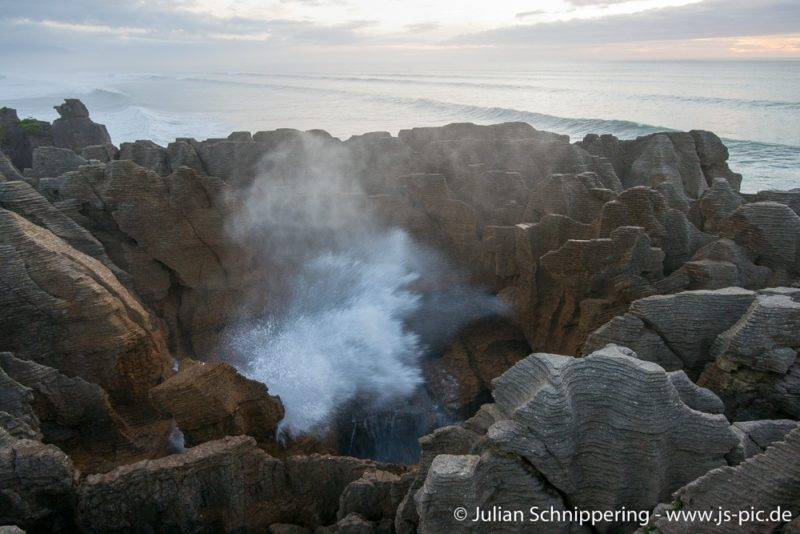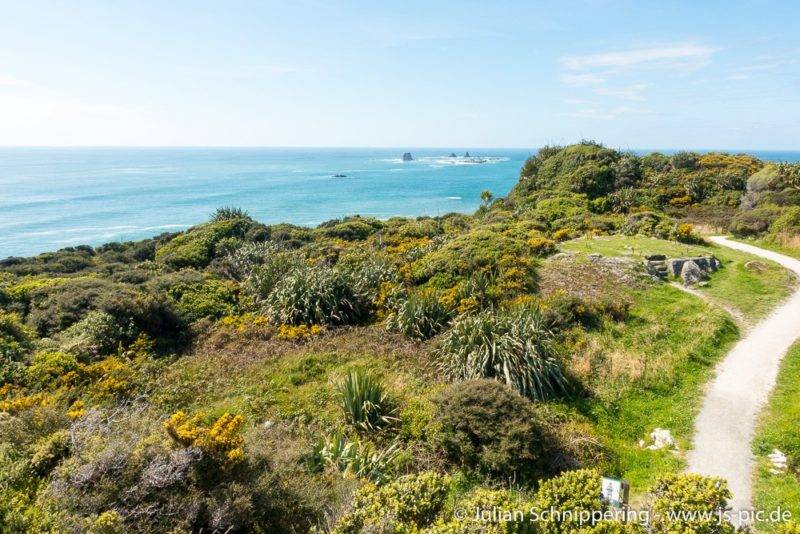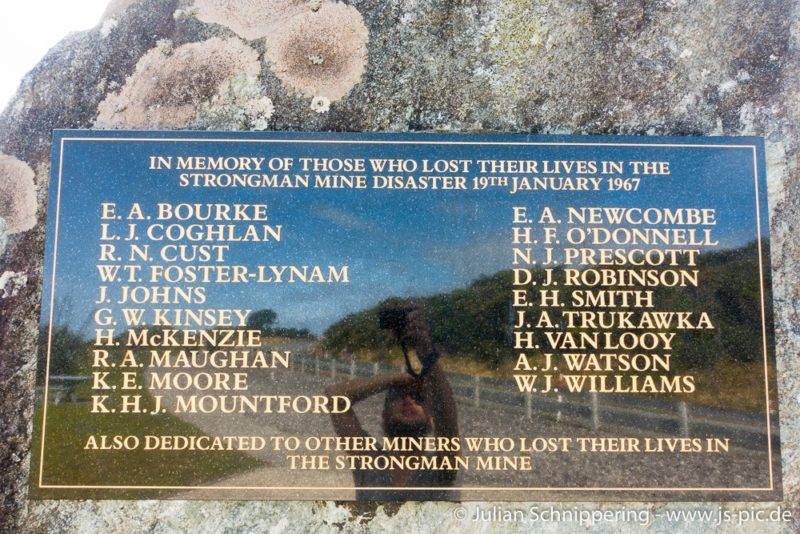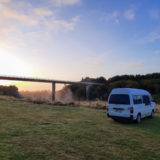Our personal highlights at the west coast of the South Island of New Zealand
In this article you can find our personal highlights on the west coast of New Zealand. From glaciers, to relics from the time of gold smoke and old mines, there is a lot to discover here.
Pancake Rocks
In the north of the west coast lies Punakaiki, only known for its spectacular pancake rocks. Through sedimentary deposits rocks grow out of the sea, layered like pancakes. The special thing about these rocks is that they grow from bottom to top, they virtually push themselves out of the sea. This creates holes in some rocks, which become blow holes at high tide and let the sea water splash several meters high as a fountain. Around the Pancake Rocks there is a nice circular path, thus, the visit is not only worthwhile at high tide – even if it is then the most spectacular!

View on the blowholes at the well known pancake rocks.
Cape Foulwind
About 45 minutes the path leads you along the coast. You pass a lighthouse with a wonderful view of the sea and the seals playing in it. The path ends at a viewing platform from which you can look directly at the seal bank. Those who do not want to walk for 1 1/2 hours can drive 15 minutes by car from the lighthouse to the seal colony to watch the little ones splashing around. With a little luck you can see yellow-eyed penguins living on a small island. Especially at sunset the Cape Foulwind is gorgeous. From a small hill you can see the sea, the seals and the reflection of the setting sun.

View from Cape Foulwind to the surroundings
Gillespies Beach
Another highlight of our last trips. Beach and campground at the Gillespies Beach. Very secluded there are also some relics from the gold-digger times to be seen.
For example, there are the rusty remains of an old gold digger. If the weather is good you have a great view here. You can see for example the surrounding Alps with some glaciers. And if you are very lucky you can even see the summit of Mount Cook.
The DOC campsite at Gillespies Beach is simple, but has everything you need. Unfortunately, there are a lot of sand-flies that are there even in winter. Nevertheless, we enjoyed our stay there very much and can recommend an overnight stay.

Gillespies Beach is one of the more rural and beautiful spots of the west coast
Franz-Josef Glacier
About 150,000 years ago it not only covered the New Zealand Alps and Mount Cook, but also had direct access to the sea. Today the Franz-Josef Glacier is about 10km long with an area of 33km^2. 25 minutes’ walk leads through the valley directly to the glacier snout, past the countless waterfalls. If you want to get a view of the glacier from above, you can take a helicopter flight, or the Roberts Point hike. One walks for 3 hours alongside the left side of the glacier in order to stand some metres above the glacier.

View from Roberts Point to the Franz Josef Glacier
Fox Glacier
In the past we never visited the Fox Glacier, because we always stopped at the Franz Josef Glacier. This year we changed that. For the very first time we got a glimpse of the Fox Glacier.
The Fox Glacier is visible since one year by a longer hike over a wide path.
The access was closed for some time due to a storm in 2019, but in the meantime the path is passable again. Depending on the weather of the previous days you can get close to the glacier in different ways. We enjoyed the little hike in any case. It is also possible with prams.

View on Fox glacier from the temporary view point
Ross Historic Goldfields
Do you also wonder what it was like during the gold rush? How people lived in the constant hope of making a valuable find soon? How the economic boom made its way into the cities? Then you should definitely come to Ross and let yourself be transported back to the time of 1860! On a one-hour round trip you follow the traces of the old gold diggers and find old pipelines, huts, mines and houses. In the rebuilt town you will even get a glimpse of a prison with old documents, a well-preserved cemetery and get a feeling of how life was lived back then.

Old remains at the Ross goldrush historical area.
Strongman Mine Memorial
The road winds through the middle of the mountains, leads through valleys, past dense forests, climbs the mountains and offers breath-taking views of the unspoilt beaches and turquoise blue sea. On one of these mountains is the “Strongman Mine Memorial”. It commemorates the mining disaster of 1967, when an explosion shook New Zealand's largest underground coal mine and killed 19 people. In the middle of this dreamlike environment, you can still feel the touching sadness of this place, on some days flowers and wreaths lie in front of the memorial.

The sign of the Strongman mine disaster remains at the street
More posts to the New Zealand Regions
We have made a map for your easy navigation, with which you can visit the respective contribution to the region directly. Have a look around what we like in the other regions!
Ask us anything
We run this blog so you can have a great time in New Zealand. All the articles and videos are free for anyone.
If you want to ask an individual question about Newzealand, your working holiday or anything else around travelling New Zealand, then this is your chance.
Even it always looks like holiday, this website and the project is a fulltime business. So you can support us with any question if you'd like.
Simply click the button and ask us, in exchange for your answer you can give what you value our time.
If every visitor would support us with 1€ per year, our business would be up running for long times. Therefore we count on your support!
A big thank you from the depth of our hearts. Julian & the team of Project-Newzealand


